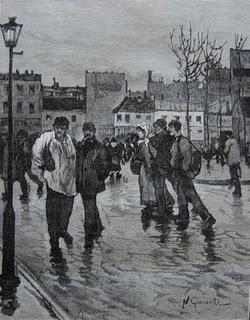 La descente des ouvriersWood engraving by Fortuné Méaulle after Norbert Goeneutte, 1878
La descente des ouvriersWood engraving by Fortuné Méaulle after Norbert Goeneutte, 1878I don’t know who the publishers engaged to art direct this complex illustrated book, but my hunch would be Regamey, the former art director of the 1870s journal Paris à l’eau-forte, to which many of these artists (though not Renoir) had contributed. I suspect the inspiration for the curious mixture of artists and styles came from the 1876 edition of Léon Cladel’s Les Va-nu-pieds, which was published by Richard Lesclide’s Librairie de l’eau-forte. This was originally announced to be illustrated with etchings by André Gill, but in the end it was illustrated with wood engravings after Gill, Regamey, Vierge, Guérard, Somm, and various other contributors to Paris à l’eau-forte. It appears that Marpon and Flammarion liked the idea of issuing novels in serial parts, using multiple illustrators in this way (although to my mind it produces in the end a book with little visual cohesion or integrity), and they proceeded to issue similar illustrated editions of various Zola novels. So far as I know, Renoir only contributed to L’Assommoir. He probably agreed to the commission because of his friendship with Zola. According to this article Zola was involved in selecting the artists, and personally approached Renoir. Renoir also owed a debt of friendship and gratitude to the original publisher of L’Assommoir, Georges Charpentier.
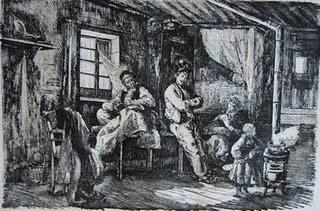 La Loge des BocheWood engraving after Pierre-Auguste Renoir, 1878
La Loge des BocheWood engraving after Pierre-Auguste Renoir, 1878130 copies were printed on handmade Hollande wove paper, each containing an additional suite of the illustrations printed on china paper; these rare copies are now immensely sought-after. But there was also a trade edition on ordinary book-wove paper. This cheap paper has not stood the test of time very well, and many copies of the ordinary edition have browned and foxed. But I have been lucky enough to find a copy in which the pages are clean and fresh.
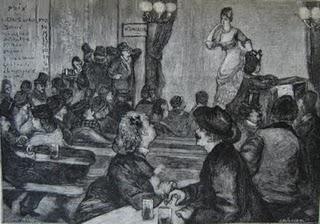 Lantier et Gervaise passèrent une très-agréable soirée au café-concertWood engraving by Henri Paillard after Pierre-Auguste Renoir, 1878
Lantier et Gervaise passèrent une très-agréable soirée au café-concertWood engraving by Henri Paillard after Pierre-Auguste Renoir, 1878Renoir’s four plates are of varying quality, I think. “Lantier et Gervaise passèrent une très-agréable soirée au café-concert”, which is signed A.R. in the bottom left of the block, and was engraved by Henri Paillard, is the most successful to my eyes. The subject-matter is perfect for Renoir, and the whole scene is brimming with life.
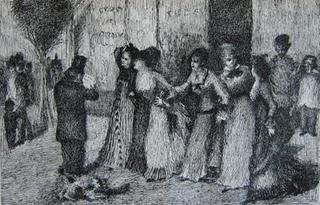 Les filles d’ouvriers se promenant sur le boulevard extérieurWood engraving after Pierre-Auguste Renoir, 1878
Les filles d’ouvriers se promenant sur le boulevard extérieurWood engraving after Pierre-Auguste Renoir, 1878“Les filles d’ouvriers se promenant sur le boulevard extérieur” is also very atmospheric. It bears the signature Renoir, again in the bottom left, but there is no indication as the identity of the engraver. The original drawing in pen and brown ink over black chalk is in the Regenstein Collection in the Art Institute of Chicago. The author of the note on it in the Art Institute of Chicago Museum Studies declares it “one of the most important drawings the artist produced during the years of high Impressionism.” A long-lost earlier version of the same composition, annotated by Zola, was discovered in an office safe in 2003, and sold at auction for £106,750.
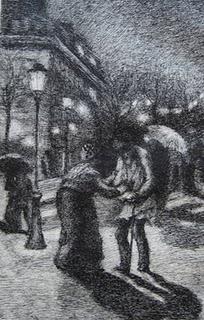 Le père Bru piétinait dans la neige pour se réchaufferWood engraving after Pierre-Auguste Renoir, 1878
Le père Bru piétinait dans la neige pour se réchaufferWood engraving after Pierre-Auguste Renoir, 1878The other two illustrations don’t seem to me to reach the same high standard. Each has its Impressionistic charm, one a cramped interior, the other a shivery exterior, but in both cases Renoir, unused to creating drawings for reproduction, has introduced so much cross-hatching that the effect is very dark, and a little confused. It’s interesting to me that in only one case of the four is the engraver credited, and that plate is, for me, much the most successful; the engraver, Paillard, was himself a noted artist. Although all the illustrations are always described as wood engravings, I passingly wondered if the other three Renoirs, and a few of the other images where no engraver is credited (such as Regamey’s "Gervaise et Coupeau", and Goeneutte’s "L’atelier de fleuristes"), might possibly be reproduced by some other process, such as Gillotage (a form of photolithography using zinc plates). It's very hard to say for sure. But I think on the whole that they probably are wood engravings - certainly, there is more detail in the published plate of Renoir's "Les filles d'ouvriers..." than there is in either of the two drawings, and all the images are reproduced purely in line, with no tone.
Below are just a few of the other illustrations to this edition of L’Assommoir, to indicate the range of talents at work on this project.
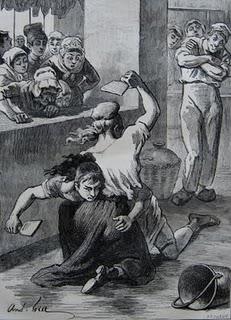 La bataille de Gervaise et VirginieWood engraving by Eugène Froment after André Gill, 1878
La bataille de Gervaise et VirginieWood engraving by Eugène Froment after André Gill, 1878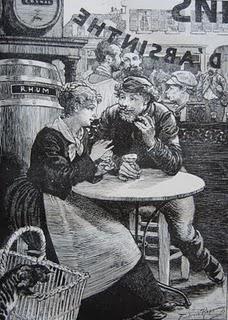 Gervaise et Coupeau, l’ouvrier zingueur, mangeaient ensemble une prune à l’AssommoirWood engraving after Frédéric Regamey, 1878
Gervaise et Coupeau, l’ouvrier zingueur, mangeaient ensemble une prune à l’AssommoirWood engraving after Frédéric Regamey, 1878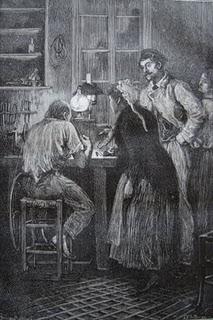 Les Lorilleux travaillant l’orWood engraving by Clément Bellenger after Georges Bellenger, 1878
Les Lorilleux travaillant l’orWood engraving by Clément Bellenger after Georges Bellenger, 1878 Ça ne vous empêchera pas d’y passer, ma petiteWood engraving by Albert Bellenger, 1878
Ça ne vous empêchera pas d’y passer, ma petiteWood engraving by Albert Bellenger, 1878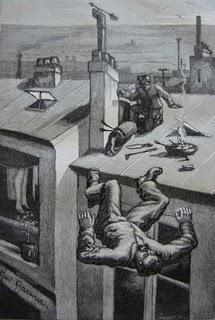 L’accident du coupeauWood engraving by Jules Léon Perrichon after Alfred Garmer, 1878
L’accident du coupeauWood engraving by Jules Léon Perrichon after Alfred Garmer, 1878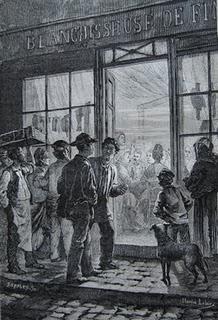 Ce fut le zingeuer qui força Lantier à entrerWood engraving by Alfred Kemplen after Maurice Leloir, 1878
Ce fut le zingeuer qui força Lantier à entrerWood engraving by Alfred Kemplen after Maurice Leloir, 1878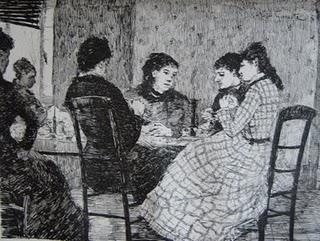 L’atelier de fleuristesWood engraving after Norbert Goeneutte, 1878
L’atelier de fleuristesWood engraving after Norbert Goeneutte, 1878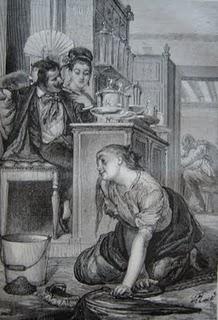 Gervaise lavant par terre dans la boutique de confiserieWood engraving by Fortuné Méaulle after Alexandre Auguste Rosé, 1878
Gervaise lavant par terre dans la boutique de confiserieWood engraving by Fortuné Méaulle after Alexandre Auguste Rosé, 1878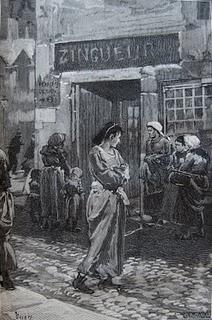 Les femmes attendant la paye à la port de l’atelierWood engraving by Clément Bellenger after Daniel Vierge, 1878
Les femmes attendant la paye à la port de l’atelierWood engraving by Clément Bellenger after Daniel Vierge, 1878



COMMENTS ( 1 )
posted on 26 January at 09:56
salut sa va ?